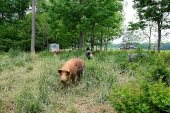














craig loyer wrote:will non native mushrooms effect the natural order of things with local fungi?




craig loyer wrote: will non native mushrooms effect the natural order of things with local fungi?








craig Longfellow wrote:There are no edible mushrooms that i have found yet and can identify. I was referring to bringing in fungi that currently do not live there and trying to make a home for them with wood chips and spawn.








craig Longfellow wrote: can you find the wood ear mushroom with snow on the ground?
 I've found lots of wood ears in Poland and Ukraine in the middle of winter. They like that dreary wet weather when the sun doesn't come out for a week.
I've found lots of wood ears in Poland and Ukraine in the middle of winter. They like that dreary wet weather when the sun doesn't come out for a week. 



 1
1




Cindi Martineau wrote:
For me, I plan to only put native plants, shrubs and trees behind our fence in the woods. This will include food for the birds and maybe some food for us too. In my yard I will have native plants, but also a huge variety of food plants. I'm planning on growing mushrooms, but I'll probably do it in the yard, unless it's something like chicken of the woods or others that I've seen in the area. In the beginning I wanted only native plants, but then I read something very convincing about how we can do more good by growing our own food than going with exclusively native plants. Now, I"m trying to strike a balance between the two. I believe many of the native plants will be good companion plants for my food. They will support local, native pollinators and they will be beautiful.
Another thing to consider before changing your woods is to try to find out if you have any sensitive areas nearby. Sometimes there are endangered or threatened plants in those areas. Purists will say that the genetic stock of those plants should not be mixed with genetics from other areas. Plants that may exist across a large span of land (across many states), may still have particular genetics for specific sites and will do better there than if you move them to a slightly different climate.









|
Spare the rod, spoil the child. Here, use this tiny ad named Rod:
Homestead Pigs Course
https://permies.com/wiki/365748/Homestead-Pigs
|






